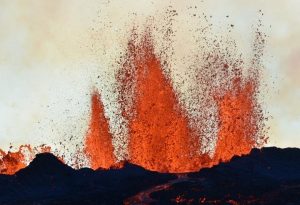
The Bárdarbunga eruption on Iceland has broken many records. The event in 2014 was the strongest in Europe since more than 240 years. The hole it left behind, the so-called caldera, is the biggest caldera formation ever observed. And the event as such was studied in unprecedented detail by a team of international scientists, amongst them a group from the GFZ German Research Centre for Geosciences. Together with lead author Magnus T. Gudmundsson from the University of Iceland, the team has now published its findings in the upcoming issue of Science.
From August 2014 to February 2015, the Bárdabunga caldera was formed in the centre of Iceland. Calderas are kettle-shaped volcanic structures with a diameter of one kilometer up to 100 kilometers. They form through the collapse of subterranean magma reservoirs during volcanic eruptions. Since their formation is not very frequent, knowledge of such calderas is scarce. As part of an international team, GFZ scientists from the section Physics of Earthquakes and Volcanoes documented the event in great detail. The scientists used satellite images, seismological and geochemical data, GPS data and modelling.
The process of subsidence was triggered by the lateral intrusion of magma from a reservoir 12 kilometers below the surface. The magma flowed for 45 kilometers along a subterranean path before erupting as a major lava flow northeast of the volcano. The subsidence was accompanied by 77 earthquakes reaching magnitudes larger than M 5.
In their study, the scientists show how the ice-filled subsidence bowl developed gradually over the course of six months to become eight by eleven kilometers wide and up to 65 meters deep. “With an area of 110 square kilometers, this is the largest caldera collapse ever monitored. The results provide the clearest picture yet of the onset and evolution of this enigmatic geological process,” says Dr. Eoghan Holohan, who led the modelling part of this work at the GFZ.
Dr. Sebastian Heimann (GFZ) investigated the mechanisms underlying the collapse using seismological methods. “The typical structure of seismic waves in volcanic eruptions can be used to infer the type of deformation directly above the magmatic chamber.” The result of his analysis indicates that steeply-dipping ring faults controlled the subsidence at depth.
Another surprise for the scientists was how the magma behaved within the canal beneath the surface. “Interestingly, the eruption site and the magma chamber were coupled hydraulically over 45 kilometers,” says Dr. Thomas Walter from the GFZ. He compares the effect to a hose pipe level. Tremors and seismic shocks at the eruption site propagated to the magma chamber at the other end and vice versa.
The chamber lies beneath Europe’s largest glacier, the Vatnajökull, and the caldera was filled with ice. Thomas Walter says: “The event was a blessing in disguise as the eruption could have happened directly beneath the ice. In that case, we’d have had a water vapour explosion with a volcanic ash cloud even bigger and longer lasting than the one that followed the eruption of Eyjafjallajökull in 2010.” For comparison: The Bárdabunga eruption blew out two cubic kilometers of volcanic material over the course of several months, nearly ten times more than the Eyjafjallajökull.
With the data they gathered, the geoscientists hope to gain deeper insights into the currently un-explored mechanisms of caldera formation. Eruptions connected to such processes can be far bigger than the observed Icelandic event. Catastrophic events can occur for instance at Yellowstone, USA, or in the Andes region. Exactly 200 years ago, the eruption of the Tambora volcano in Indonesia and the subsequent caldera formation lead to an atmospheric shock wave that could be measured globally as well as to a devastating tsunami. The volcanic aerosols and ash in the stratosphere brought the infamous “year without summer” in 1816.
Reference:
M. T. Gudmundsson, K. Jonsdottir, A. Hooper, E. P. Holohan, S. A. Halldorsson, B. G. Ofeigsson, S. Cesca, K. S. Vogfjord, F. Sigmundsson, T. Hognadottir, P. Einarsson, O. Sigmarsson, A. H. Jarosch, K. Jonasson, E. Magnusson, S. Hreinsdottir, M. Bagnardi, M. M. Parks, V. Hjorleifsdottir, F. Palsson, T. R. Walter, M. P. J. Schopfer, S. Heimann, H. I. Reynolds, S. Dumont, E. Bali, G. H. Gudfinnsson, T. Dahm, M. J. Roberts, M. Hensch, J. M. C. Belart, K. Spaans, S. Jakobsson, G. B. Gudmundsson, H. M. Fridriksdottir, V. Drouin, T. Durig, G. Athalgeirsdottir, M. S. Riishuus, G. B. M. Pedersen, T. van Boeckel, B. Oddsson, M. A. Pfeffer, S. Barsotti, B. Bergsson, A. Donovan, M. R. Burton, A. Aiuppa. Gradual caldera collapse at Bardarbunga volcano, Iceland, regulated by lateral magma outflow. Science, 2016; 353 (6296): aaf8988 DOI: 10.1126/science.aaf8988
Note: The above post is reprinted from materials provided by GFZ GeoForschungsZentrum Potsdam, Helmholtz Centre.









